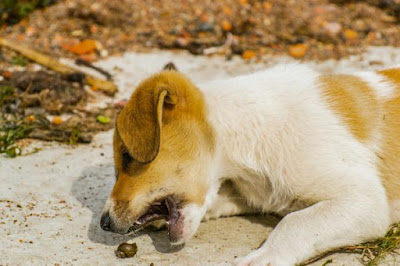Although it is not a common practice, we as caregivers may find ourselves faced with a situation in which our dog swallows a snail or a slug, especially if we have an orchard or garden where these breed slugs and, therefore, have easy access to the animal. for them.
Although it may seem like a simple joke, in this dog57 article we'll see what would happen if a dog eats a snail, as these mollusks can transmit fatal diseases. Avoiding ingestion and the correct schedule for deworming is essential.
Diseases transmitted by snails to dogs: vascular disease
Worms can cause coagulopathy in our dog, low platelet count, pulmonary arterial obstruction, thrombosis, lesions due to larval respiratory migration, congestive heart failure, cough, failure, exercise intolerance, anemia, bleeding, bruising, neurological signs and deficiency in weight, and even death.
This parasite is native to Europe but is expanding and can already be found in other countries. What happens if a dog eats a snail infected with this worm is that it will ingest its L3 larvae, which will travel to its heart, specifically the right ventricle and pulmonary artery, where they complete their development into adulthood.
Mature females lay eggs that, through the bloodstream, reach the pulmonary capillaries where they hatch into L1 larvae that travel to the alveoli. When a dog sneezes or coughs, these larvae reach the mouth and are swallowed, end up in the digestive system, and are expelled with feces. Among them, the larvae reach different species of snails or slugs, where they will develop up to level 3, with the cycle restarting if eaten by a dog.
Sometimes a dog gets infected by eating frogs, lizards, or even mice because these animals can also become infected if they eat shellfish. As we have seen, the symptoms of this parasite are completely nonspecific, so the veterinarian should be the one who arrives at the diagnosis.
Larvae can be observed in the feces, although this technique gives false-negative results because elimination is intermittent. Blood tests, X-rays, or ultrasounds can be done, but due to their small size, these worms will not be seen.
Due to the dire consequences of this parasite can cause, it is essential to maintain the correct deworming guidelines to prevent it, following the recommendations of our vet. In this sense, although there are many anti-parasitic products, specialists recommend choosing a monthly deworming, especially in dogs that have daily access to field areas, with snails, slugs, ticks, and fleas.
Similarly, to avoid giving more than one product to the animal, it should be noted that there is a double deworming process, through which we can protect dogs from the most common internal and external parasites, using one tablet. Because we love them, we protect them, and we ask your vet to deworm your pet.
You may also be interested in: Types of Worms in Dogs - Symptoms and Remedies
Diseases transmitted by snails to dogs:
This disease, also known as roundworm pneumonia, is caused by another roundworm or nematode, which infects the lungs and reaches our dogs if they eat infected mollusks. What happens if a dog eats a snail or a slug similar to the cycle we described, with the difference that these parasites end in the bronchi and, in some cases, the trachea. Places where adult females lay eggs that will develop into L1 larvae.
In the same way as in the previous case, through coughing, sneezing or sputum, these larvae end in the digestive tract and are expelled in the feces, where they penetrate the slugs or snails, continuing their growth until the L3 larvae. If your dog swallows a contaminated snail or slug, the larvae will travel from the intestines to the lungs via the bloodstream within about three weeks. In the lungs, they will complete their cycle. Adults can live up to 10 months.
Due to their location, the clinical signs that we will find in dogs will affect breathing, exhibit coughing, and exercise intolerance, although many dogs remain asymptomatic. This disease is usually present in rural areas with livestock, since they are usually the main affected, and although it is not usually serious, it is essential to prevent it through adequate deworming. It should be noted that it is not contagious to humans.
General recommendations to prevent your dog from eating snails
Now that we know what will happen if our dog eats a snail or, well, a slug, we will see how we can reduce the risks:
Teach our dog not to eat anything he finds outside the house.
If he has frequent access to an area with an abundance of snails or slugs, we must make sure he does not eat them.
Living in close quarters with fox populations also increases the risk, as these animals can act as reservoirs.
Traces left by slugs on surfaces they move on can also be a source of infection.
Since worms in foxes or slugs are difficult to control, it is essential to establish and follow the deworming guidelines recommended by our veterinarian.
Finally, we should go to the vet before any symptoms appear.
This article is informational only, at dog57.com we do not have the authority to prescribe veterinary treatments or make any kind of diagnosis. We invite you to take your pet to the vet in case he is under any type of condition or discomfort.



.jpg)


.jpg)


.jpg)
ليست هناك تعليقات:
إرسال تعليق